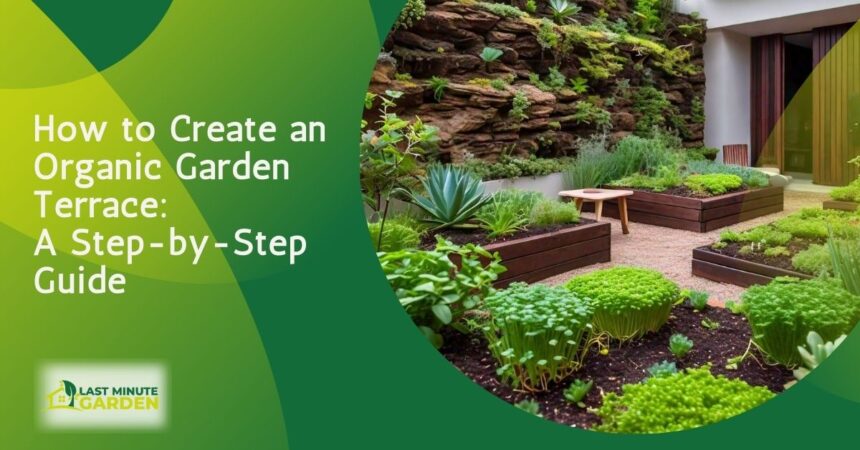Are you ready to turn your urban space into a green haven? We’re about to elevate your outdoor area with an organic garden terrace. Picture yourself working in rich, organic soil, feeling the sun’s warmth. You can grow everything from veggies to flowers on your terrace.
This guide will show you how to mix nature with home comfort. You’ll learn to create a garden that’s lush and full of life.
Let’s start this journey to a greener, more vibrant life.
Challenges of Gardening on Sloping Terrains
Gardening on a sloping terrain can be a unique adventure, but it comes with its own set of challenges. If you’ve ever tried to plant a garden on a hillside, you know it’s not as straightforward as gardening on flat ground.
Here are some common challenges you might face.
1. Soil Erosion
One of the biggest issues with sloping gardens is soil erosion. When it rains, water tends to flow downhill, taking valuable topsoil and nutrients with it. This can leave your plants without the essential nutrients they need to grow.
2. Water Drainage
Water drainage can be tricky on slopes. While too much water runs off quickly, some areas might end up too dry, and others might stay too wet. This uneven moisture distribution can stress your plants.
3. Access and Maintenance
Working on a slope can be physically challenging. Planting, weeding, and harvesting require more effort and can be less safe than on flat terrain.
4. Soil Quality
The quality of soil on a slope can vary greatly. The top of the slope might have rocky, shallow soil, while the bottom could be richer but overly wet.
5. Sunlight Exposure
Slopes can have varying sunlight exposure. One side might be in full sun, while the other is shaded, affecting what you can grow.
6. Plant Stability
Plants on a slope can struggle to anchor their roots properly, especially in loose soil, making them more vulnerable to being uprooted by wind or water.
It is possible that all these obstacles would deter you from creating your ideal garden. However, terrace gardening can help with that!
Let’s look at how terracing solves the problems.
Benefits of Terrace Gardening
Terrace gardening is an excellent solution for gardening on sloping terrains.
Here are some of the benefits of terrace gardening:
1. Erosion Control
Terrace gardening significantly reduces soil erosion. By creating level areas, you prevent water from rushing downhill and taking valuable topsoil with it. This helps retain the nutrients in the soil, ensuring your plants have what they need to thrive.
2. Efficient Water Usage
Terraces help manage water distribution more effectively. Instead of water flowing straight down the slope, it gets absorbed more evenly across the terraced levels. This means your plants get the right amount of water, reducing the risk of both waterlogging and drought.
3. Improved Soil Quality
Terraces allow you to build and maintain better soil structure. You can add compost, mulch, and other organic matter to each terrace, enriching the soil and creating an ideal growing environment for your plants. This is much easier to manage than trying to amend soil on a steep slope.
4. Increased Plant Variety
With terraces, you can create different microclimates and soil conditions on each level. This allows you to grow a wider variety of plants, as you can tailor each terrace to the specific needs of different crops. You can have sun-loving plants on the upper terraces and shade-tolerant ones on the lower levels.
5. Ease of Maintenance
Terraces make gardening on slopes safer and more accessible. The flat surfaces are easier to walk on, reducing the risk of slips and falls. This makes tasks like planting, weeding, and harvesting much more manageable. You can also create convenient paths and steps between terraces.
6. Enhanced Aesthetic Appeal
Terraced gardens can be visually stunning. They add structure and layers to your landscape, creating a unique and attractive garden design. You can incorporate retaining walls, decorative plants, and even water features to enhance the beauty of your garden.
7. Maximized Space
Terracing makes the most of available space on a slope. By creating multiple levels, you increase the planting area compared to a single sloped surface. This maximizes the use of your land, allowing you to grow more plants in the same amount of space.
8. Better Crop Yield
Terraced gardens can lead to better crop yields. With improved soil quality, efficient water use, and reduced erosion, your plants are likely to be healthier and more productive. This means you can enjoy a more bountiful harvest from your terraced garden.
Step-by-Step Guide to Creating a Terrace Garden
Creating a terrace garden might seem like a big task, but breaking it down into simple steps makes it manageable and fun.
Here’s how you can transform your sloping yard into a beautiful terraced garden.
Step 1 Plan Your Garden
Start by sketching a rough plan of your garden. Decide how many terraces you want and where they will go. Consider the types of plants you want to grow and their sunlight and water needs. This planning stage is crucial as it will guide the entire process and ensure that your garden is both functional and beautiful.
Step 2 Mark the Contour Lines
Using stakes and string, mark the contour lines on your slope. These lines should be level and represent where each terrace will be built. It helps to use a level or a laser level to make sure your lines are accurate. This step ensures that your terraces will be even, which is important for both aesthetics and preventing erosion.
Step 3 Start Digging
Begin at the bottom of your slope and dig a trench along your first contour line. The trench should be wide and deep enough to hold the retaining wall material you’ll use, usually around 6-12 inches deep depending on the material. This foundational step is crucial for stability.
Step 4 Build the Retaining Wall
Place your retaining wall material in the trench. Common materials include wood, stone, bricks, or concrete blocks. Make sure it’s sturdy and level. This wall will hold back the soil and create your first flat terrace. If you’re using wood, treat it to resist rot. Stone and bricks should be tightly packed to prevent shifting.
Step 5 Fill and Level the Terrace
Fill the area behind the retaining wall with soil, compost, and other organic matter. Use a rake to level the soil, creating a flat planting area. This will be your first terrace. Make sure the soil is packed down lightly but evenly, providing a stable base for planting.
Step 6 Repeat for Additional Terraces
Move up the slope and repeat the process for each additional terrace. Dig a trench, build the retaining wall, and fill it with soil. Make sure each terrace is level with the one below it. This step-by-step approach helps maintain a consistent gradient and makes construction easier.
Step 7 Install Irrigation
Terrace gardens benefit from efficient water distribution. Consider installing a drip irrigation system or soaker hoses to ensure each terrace gets adequate water without runoff. This is especially important on slopes where water can easily flow away before it soaks into the soil.
Step 8 Plant Your Garden
Now comes the fun part—planting! Start planting your chosen vegetables, flowers, or shrubs in each terrace. Group plants with similar water and sunlight needs together. This not only makes watering easier but also ensures that each plant gets the right amount of light.
Step 9 Mulch and Maintain
Apply mulch to help retain moisture and prevent weeds. Regularly check your terraces for erosion or wall damage, and maintain them as needed. Mulching also helps keep the soil temperature stable and adds organic matter as it decomposes.
Step 10 Enjoy Your Garden
Sit back and enjoy the fruits (and veggies!) of your labor. Your terraced garden will not only look stunning but also provide a productive space for your plants. Take time to relax in your garden, and enjoy the beauty and bounty you’ve created.
Soil Essentials of Organic Terrace Gardening
To start a thriving organic terrace garden, focus on the soil. Add lots of organic stuff like well-composted manure, peat moss, or homemade compost. These help give your plants the nutrients they need and keep the soil healthy.
Put a 1-2 inch layer of organic mulch down, like coco coir, straw, or newspaper. Mulch stops weeds and keeps the soil moist.
Organic Garden Soil and Mulch
Healthy, rich soil is key for a great organic terrace garden. Adding organic stuff helps feed your plants and supports good microbes. These microbes break down nutrients so your plants can use them better.
Organic mulch keeps weeds away and saves soil moisture. It’s like a protective blanket for your soil.
Using an Organic Garden Fertilizer
Use well-rotted manure or organic fertilizers to make your plants grow strong and give lots of food. But don’t overdo it, as too much can attract pests and diseases. A balanced fertilizer plan is best for your plants’ health.
Building nutrient-rich soil and using organic fertilizers makes for a great organic terrace garden. This way, you feed your plants and help a bunch of good organisms live in your garden. It leads to a healthier and more productive garden.
Conclusion
By following this guide, you can turn a tough, sloping area into a beautiful and useful organic garden terrace. The secret is to use your land’s special features well.
With some creativity and hard work, your organic terrace garden can become a peaceful spot. So, don’t let a sloping yard stop you.
Take on the challenge and show off your gardening skills on the perfect organic garden terrace.




